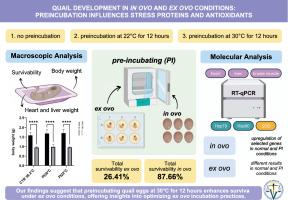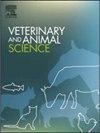鹌鹑在蛋内和蛋外条件下的发育:预孵化影响应激蛋白和抗氧化剂
IF 1.9
Q2 AGRICULTURE, DAIRY & ANIMAL SCIENCE
引用次数: 0
摘要
极端温度,无论是过高还是过低,都是生物体的关键环境压力源,深刻影响细胞代谢和体内平衡。本研究探讨了不同孵育条件对鹌鹑发育过程中关键应激相关基因(HSP70、HSP90和SOD1)表达的影响。鹌鹑蛋用三种不同的方法孵育:38.2℃标准孵育和22℃或30℃预孵育,在蛋和除蛋条件下孵育。结果表明:卵外培养的胚胎存活率(26.41%)明显低于卵内培养的存活率(87.66%)。在鸡蛋组中,30°C预孵育的存活率最高(43.48%),说明最佳预孵育温度的关键作用。与除卵组相比,卵内组的胚胎总重量显著增加。此外,30°C预孵育导致鸡蛋组心脏和肝脏重量增加。基因表达分析显示不同孵育方法之间存在明显差异。在孵育前两种温度下,蛋内孵育导致所有被检查器官(肝脏、心脏和胸肌)的基因表达均匀增加,而蛋外条件显示出混合结果:肝脏(SOD1)和肌肉(HSP70、SOD1)的基因表达减少,但肝脏(HSP70)和心脏(SOD1)的基因表达显著增加。我们的研究结果表明,在30°C下预孵鹌鹑蛋12小时可以提高卵外条件下的存活率,为优化卵外孵育实践提供了见解。本文章由计算机程序翻译,如有差异,请以英文原文为准。

Quail development in in ovo and ex ovo conditions: Preincubation influences stress proteins and antioxidants
Extreme temperatures, whether excessively high or low, are critical environmental stressors for organisms, profoundly impacting cellular metabolism and homeostasis. The presented study addresses the effects of varying incubation conditions on the expression of key stress-related genes (HSP70, HSP90, and SOD1) during quail development. Quail eggs were incubated using three distinct methods: standard incubation at 38.2°C and preincubation at either 22°C or 30°C in both in ovo and ex ovo conditions. Results revealed a distinctive contrast in survival rates: embryos cultured ex ovo showed significantly lower viability (26.41 %) compared to the in ovo method (87.66 %). Among ex ovo groups, preincubation at 30°C yielded the highest survival rate (43.48 %), highlighting the critical role of optimal preincubation temperature. The preincubation period resulted in a notable increase in the total weight of embryos in the in ovo group when compared to the ex ovo group. Additionally, preincubation at 30°C resulted in increased weight of the heart and liver in the in ovo group. Gene expression analysis showed clear differences between incubation methods. While in ovo incubation led to uniformly increased gene expression across all examined organs (liver, heart, and breast muscle) at both preincubation temperatures, the ex ovo conditions exhibited mixed results: decreased gene expression in the liver (SOD1) and muscle (HSP70, SOD1) but notable increased in the liver (HSP70) and heart (SOD1). Our findings suggest that preincubating quail eggs at 30°C for 12 h is associated with improved survival under ex ovo conditions, providing insights into optimizing ex ovo incubation practices.
求助全文
通过发布文献求助,成功后即可免费获取论文全文。
去求助
来源期刊

Veterinary and Animal Science
Veterinary-Veterinary (all)
CiteScore
3.50
自引率
0.00%
发文量
43
审稿时长
47 days
 求助内容:
求助内容: 应助结果提醒方式:
应助结果提醒方式:


